The Huawei MateBook 16 Review, Powered by AMD Ryzen 7 5800H: Ecosystem Plus
by Dr. Ian Cutress on October 20, 2021 8:00 AM EST- Posted in
- Laptops
- AMD
- Huawei
- Matebook
- Ryzen
- Zen 3
- MateBook 16
- Huawei Share
- Ryzen 7 5800H
Display, Battery Life, and Charging
The Monitor
The high-level specifications of the monitor make for very interesting reading. A 16-inch IPS display with a 2520x1680 resolution, making it a 3:2 ratio (which is becoming more and more common on laptops of all sizes). The IPS panel means that the viewing angles are wide, and Huawei rates the screen for 300 nits brightness maximum as well as a 1500:1 contrast ratio. That brightness maximum isn’t anything to write home about – in fact it’s a bit low for any external daytime use – but the contrast ratio is better than the MateBook X Pro we last reviewed because of the lower blacks. On colors, Huawei pre-calibrates the display to a dE below 1, qualifying the display for 100% of the sRGB gamut with 8-bit + FRC support.
That gives a lot to play with, so here are our results:
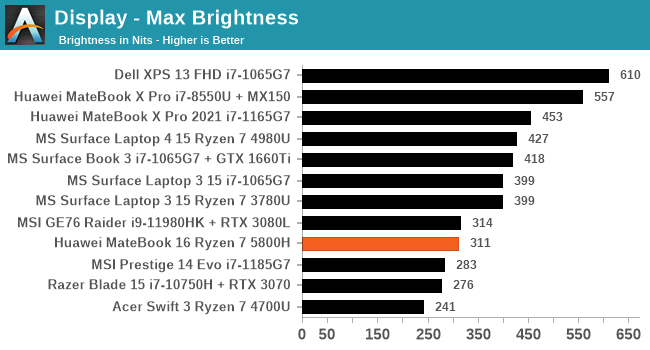
The specification sheet said 300 nits, and we scored 311. Our 200 nits regular battery testing was at a brightness setting of 65, with a very linear profile sweep.
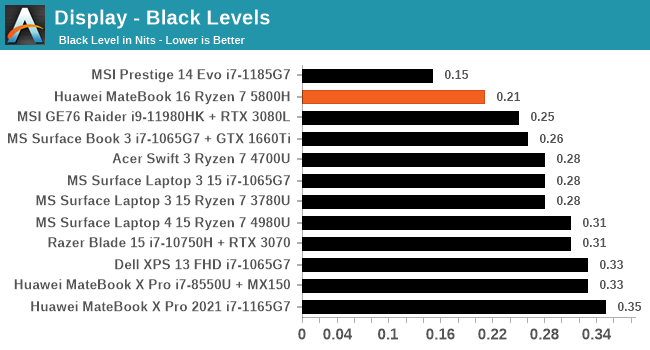

The display has some of the better black levels at maximum brightness that we’ve tested, giving a 1488:1 contrast ratio, which is almost identical to the rating.
The odd resolution of 2520x1680 is a little left-field: Huawei calls it a 2.5K+ display. But what it really comes down to is the 3:2 version of 2560x1600, which is a 16:10 ratio. The only thing really missing from the display is the lack of a touchscreen. For certain office workloads, having a touchscreen is quite handy, although it does tend to add a little weight.
For those looking for color accuracy, unfortunately I do not have the same equipment Brett does for this, however my colorimeter provides the following at 200 nits:
This shows that the red tracking is almost perfect, with the greens and the blues being biased away from that proportional line.
Battery Life
Due to the short time we had, I was only able to run one battery life test, and chose our Web Playback test that uses MS Edge to cycle through a number of remote server-driven but fixed webpage workloads. The screen brightness is set to 200 nits. Power numbers are reverse calculated mWh reported by Windows.
After the initial caching of the webpages, the system settled down into a 6-8 for most of the test. At around 550 minutes, we see a decrease in the system activity, which we’re attributing to the system entering the low power plan at 20% total battery, which surprisingly picks up again after an hour around 15% battery. The total battery life in this case, from 100% charge to shutdown (which this laptop was set at 2%, but Windows cuts at 2.5%) is 697 minutes.
Charging
So here’s where it gets a bit interesting. The laptop has a 35W/45W processor, an 84 Wh battery, and a 135 W power charger. The performance mode can only be accessed when the charger is equipped. But in a charging scenario, we get three different variants:
- When the system is idle, it will charge the battery at around 35 W and draw 50 W at the wall.
- If the display is closed, regardless of the sleep state, the battery will charge at 70 W and draw 70-90 W at the wall.
- Only when performance mode is active, and the CPU is being used fully, does the charger draw its full 135W setting.
One of the key features of this unit is the fast charging and the bundled 135 W charger. But users should note that it never charges at 135 W, but it will draw that much at the wall when the system is in use under a high-performance load. We did charging runs for both the first and second modes, with the display set to 200 nits but otherwise the system was idle.
In the 70W charging mode, the system charges at 70 W for 42 minutes, before dropping to 60 W for 8 minutes, then trickling down until ~82 minutes where it ramps up again for a seemingly final push. In this mode, we get the following:
- 10 minutes charge gets from 1696 to 13466 mWh (15.8%)
- 30 minutes charge gets from 1696 to 36374 mWh (42.8%)
- 90% charge takes 71.3 minutes
When we move down to the 35W mode, while the system is in the default Balanced CPU mode rather than Performance CPU mode, it takes a lot longer:
Here we start with an initial power wobble (for whatever reason this laptop doesn’t like accurately refreshing its battery power below 5%), and then get a constant 35 W battery charge until 90%, then it switches charging modes until 95%, and the PMIC increases charging again. In this mode, we get the following:
- 10 minutes charge gets from 1662 to 5925 mWh (7.1%)
- 30 minutes charge gets from 1662 to 17408 mWh (20.9%)
- 90% charge takes 130.2 minutes
I can certainly see the reason for having a slower charge while the lid is up – if there would be a thermal build-up on charging, the lid up means that while the laptop is in use, and so the user is not affected. It also gives room for when the system needs to go full bore. The downside is knowing that shutting the lid doubles the charging rate, so if you need a quick charge before going somewhere, it’s going to be beneficial to close the laptop lid and wait, unable to use the device, than to continue charging and working.

It should be noted that when our review unit arrived, the 135 W charger was effectively DoA; a second one arrived the day before our review embargo lifted (I unfortunately went on holiday, so this review was completed after I returned). That second charger has worked flawlessly, so I can only assume we had a (rare) dud charger. During the interim, I had other Huawei 65 W chargers from other products around for testing, and those worked without issue.


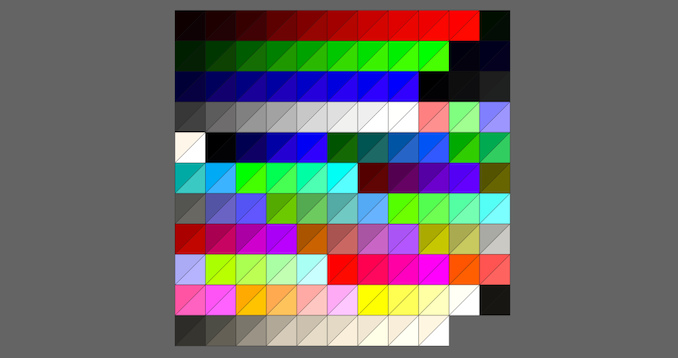
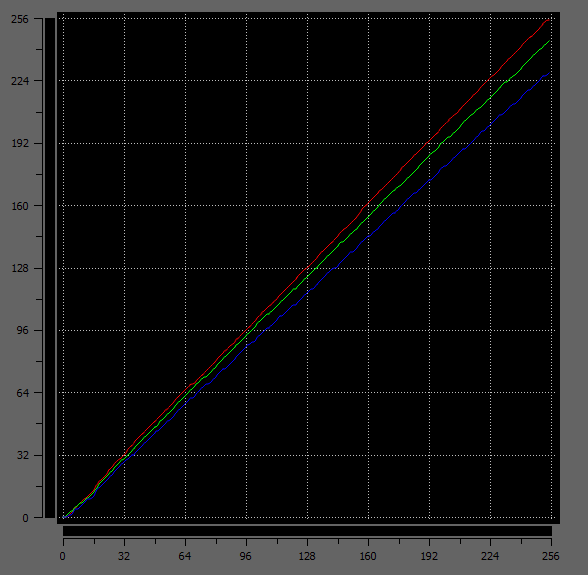
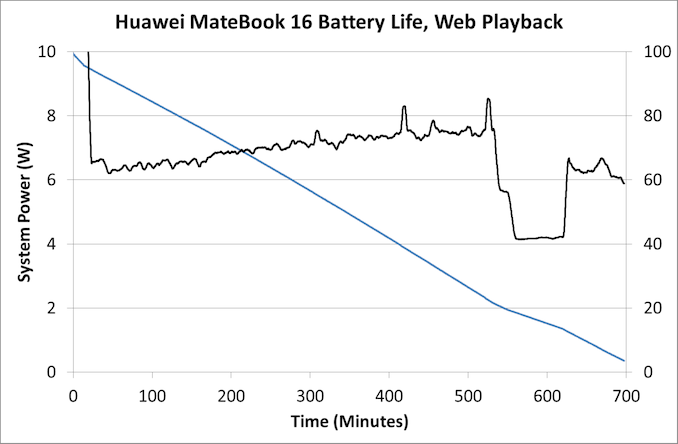

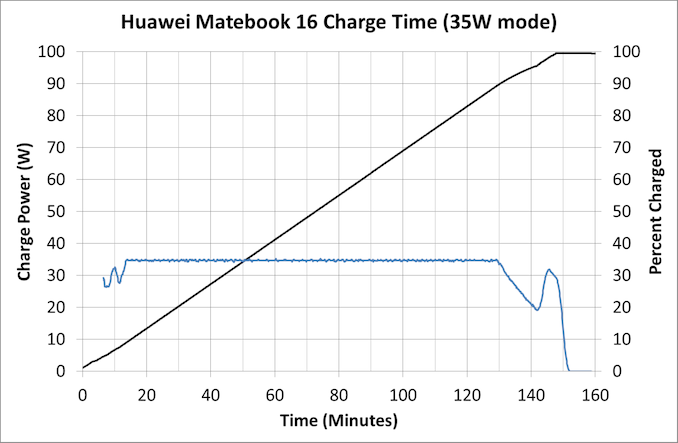








87 Comments
View All Comments
TheinsanegamerN - Wednesday, October 20, 2021 - link
Good to see another company jump on the "use a 45w ryzen chip without a dGPU" train, letting that iGPU stretch its legs a bit mroe. Shame it limits TDP so much, the mechrevio1 is a similar laptop that doesnt do that, rather allows up to 54 watt. But the huwaei has that gorgeous 16:10 display.....We need mroe of these types of laptops, and less of the dell/HP/lenovo garbage weve been getting.
at_clucks - Thursday, October 21, 2021 - link
We would have had a Kirin M1-like CPU soon if Huawei wasn't targeted by the restrictions on using US tech. Somehow those restrictions don't apply when buying straight up from Qualcomm or AMD, only when competing with them.So while I love to see mobile devices based on AMD CPUs, I would very much have loved even more to see a proper ARM SoC in there, giving M1 a run for its money. SOmething that's not tied to MacOS for example. And no, I don't consider ARM Surfaces to be that.
Arsenica - Thursday, October 21, 2021 - link
Nah, Huawei only licensed IP cores straight from ARM.At most they would have an Exynos 2000 equivalent (Cortex X1 and Mali G78 cores).
blanarahul - Wednesday, October 20, 2021 - link
"I’m a fan of notebooks that promise good power and battery life at the expense of graphics.""I have some software in my daily toolset that doesn’t work on either, so until then, I’m still focused on devices built with AMD or Intel."
Cannot agree more. I recently got a gaming notebook and while having a discrete GPU is nice, having a modern processor that is allowed to consume up to 30-40 watts and strech its legs makes a world of difference in terms of responsiveness in the applications I need to use on a day to day basis (which cannot run on Linux or Mac).
I wonder what difference Alder Lake will make with its 6 P + 8 E cores design to responsiveness and battery life.
Alistair - Wednesday, October 20, 2021 - link
and yet I've been trying to sell my top of the line CPU laptop (Ryzen 4800H) for $650 (it has a 1650 ti) and you'll find nobody wants it, I think gaming has taken over the vast majority of the market, CPU aficionados tend to have less computer knowledge, and think any Intel quad core is the same as an AMD 8 coreMccaula718 - Wednesday, October 20, 2021 - link
Your Zen 2 cpu is not top of the lineat_clucks - Thursday, October 21, 2021 - link
That's not really the problem, it's close enough to it when it comes to AMD's mobile lineup. But most people have no brand awareness when it comes to AMD, and Intel has a much more powerful brand that will attract regardless of actual performance standing, even price. And futhermore, these days a 5 year old decent laptop still does the job fine for regular day to day things. So the market for midrange new laptops (meaning not cheap low end, not superfast high end) might be smallish.You can't get a proper PC GPU so you go for the next best with a mobile GPU where the whole device is still cheaper than the PC GPU. Or you get a cheap laptop that does browsing and the likes. The offer presented above is smack in the middle.
Alistair - Thursday, October 21, 2021 - link
the 4800h was the best CPU you could buy a year ago, now it is second best, yes it isblanarahul - Thursday, October 21, 2021 - link
In my entire social circle, I am the only one who knows AMD makes excellent CPUs and GPUs as well. They all think Intel is the only one who makes CPUs (for laptops) and Nvidia is the only one that makes dGPUs. They find AMD to be "sketchy". It is upsetting but it is what it is.AMD needs to succeed in consoles and workstation/server market because as much as I hate it, Windows + Intel + Nvidia is just too powerful a combo (in terms of market presence) in the mainstream consumer market.
Alistair - Thursday, October 21, 2021 - link
exactly, that's the problem, someone actually thinks the 11400h is faster than the 4800h for example :/